Author Archives: george
ZOOTOPIA
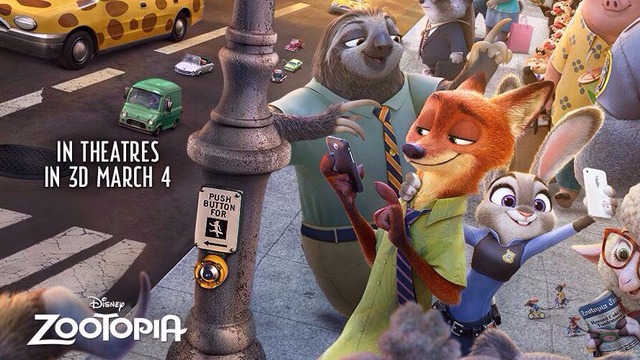
Ginnifer Goodwin voices the character of Judy Hopps, a perky rabbit who has a dream of becoming a police officer in Zootopia. In Zootopia, all animals–both prey and predictors–live in peace. In a world populated by anthropomorphic mammals, there is crime. When 14 animals disappear, Judy Hopps follows the clues to discover the plot behind the kidnappings. Jason Bateman voices Nick Wilde, a red fox con artist. Their relationship, the dynamics of various animal groups, and the message of most Disney films (“We must all work together”) could have veered into mawkishness. But Zootopia brings its animated characters to life on the screen. The mystery is clever, too. I really liked this surprising hit. GRADE: A
FORGOTTEN BOOKS #364: THE SCIENCE FICTION CENTURY By David Hartwell

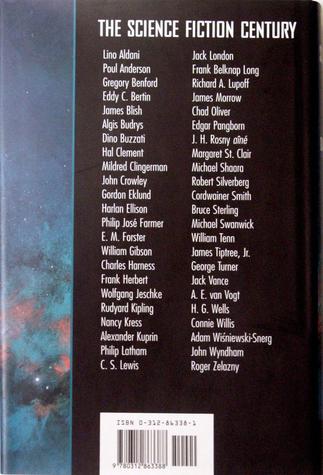
After David Harwell’s recent death, I thought I would honor his long and successful career as an editor by featuring one of his best anthologies: The Science Fiction Century. This 1000-page tome from 1997 displays the best science fiction of the 20th Century (in Hartwell’s opinion). Check out the Table of Contents below to see the range of stories in this massive volume. Hartwell provides informative introductions to each story and helps place it in the historical continuum of science fiction from the past century. If you’re looking for a landmark anthology, The Science Fiction Century is one of the best.
TABLE OF CONTENTS:
ntroduction by David G. Hartwell
“Beam Us Home” by James Tiptree, Jr. (Galaxy Magazine, April 1969)
“Ministering Angels” by C. S. Lewis (Saturday Review of Literature, May 28, 1955)
“The Music Master of Babylon” by Edgar Pangborn (Galaxy Science Fiction, November 1954)
“A Story of the Days to Come” by H. G. Wells (Pall Mall Magazine, 1899)
“Hot Planet” by Hal Clement (Galaxy Magazine, August 1963)
“A Work of Art” by James Blish (Science Fiction Stories, July 1956)
“The Machine Stops” by E. M. Forster (Oxford and Cambridge Review, November 1909)
“Brightness Falls from the Air” by Margaret St. Clair (The Magazine of Fantasy and Science Fiction, April 1951)
“2066: Election Day” by Michael Shaara (Astounding Science Fiction, December 1956)
“The Rose” by Charles L. Harness (Authentic Science Fiction Monthly #31, March 1953)
“The Hounds of Tindalos” by Frank Belknap Long (Weird Tales, March 1929)
“The Angel of Violence” by Adam Wiśniewski-Snerg (1978; translated from the Polish)
“Nobody Bothers Gus” by Algis Budrys (Astounding Science Fiction, November 1955) — Hugo nominee
“The Time Machine” by Dino Buzzati
“Mother” by Philip José Farmer (Thrilling Wonder Stories, April 1953)
“As Easy as A.B.C.” by Rudyard Kipling (The London Magazine, March 1912)
“Ginungagap” by Michael Swanwick (TriQuarterly 49, 1980) — Nebula nominee
“Minister Without Portfolio” by Mildred Clingerman (The Magazine of Fantasy and Science Fiction, February 1952)
“Time in Advance” by William Tenn (Galaxy Science Fiction, August 1956)
“Good Night, Sophie” by Lino Aldani (1963, translated from the Italian in 1973)
“Veritas” by James Morrow (Synergy: New Science Fiction, Number 1, 1987)
“Enchanted Village” by A. E. van Vogt (Other Worlds Science Stories, July 1950)
“The King and the Dollmaker” by Wolfgang Jeschke (1961, translated 1970)
“Fire Watch” by Connie Willis (Isaac Asimov’s Science Fiction Magazine, February 1982) — Hugo & Nebula Award
“Goat Song” by Poul Anderson (The Magazine of Fantasy and Science Fiction, February 1972) — Hugo & Nebula Award
“The Scarlet Plague” by Jack London (London Magazine, June 1912)
“Drunkboat” by Cordwainer Smith (Amazing Stories, October 1963)
“Another World” by J. H. Rosny aîné (1895, translated 1962)
“If the Stars Are Gods” by Gordon Eklund and Gregory Benford (Universe 4, March 1974) — Nebula Award
“I Still Call Australia Home” by George Turner (Aurealis #1, April 1990)
“Liquid Sunshine” by Alexander Kuprin (1913, translated from Russian in 1982)
“Great Work of Time” by John Crowley (Novelty, May 1989) — World Fantasy Award, Nebula nominee
“Sundance” by Robert Silverberg (The Magazine of Fantasy and Science Fiction, June 1969)
“Greenslaves” by Frank Herbert (Amazing Stories, March 1965)
“Rumfuddle” by Jack Vance (Three Trips in Time and Space: Original Novellas of Science Fiction, 1973)
“The Dimple in Draco” by R. S. Richardson (Orbit 2, June 1967)
“Consider Her Ways” by John Wyndham (Sometime, Never, 1956)
“Something Ending” by Eddy C. Bertin (1971, translated 1982)
“He Who Shapes” by Roger Zelazny (Amazing Stories, January 1965) — Nebula Award
“Swarm” by Bruce Sterling (The Magazine of Fantasy & Science Fiction, April 1982) — Hugo & Nebula nominee
“Beggars in Spain” by Nancy Kress (Isaac Asimov’s Science Fiction Magazine, April 1991) — Hugo & Nebula Award
“Johnny Mnemonic” by William Gibson (Omni, May 1981) — Nebula nominee
“Repent, Harlequin!” Said the Ticktockman” by Harlan Ellison (Galaxy Magazine, December 1965) — Hugo & Nebula Award
“Blood’s a Rover” by Chad Oliver (Astounding Science Fiction, May 1952)
“Sail the Tide of Mourning” by Richard A. Lupoff (New Dimensions 5, April 1975) — Hugo & Nebula nominee
THE GATES/THE INFERNALS/THE CREEPS By John Connolly
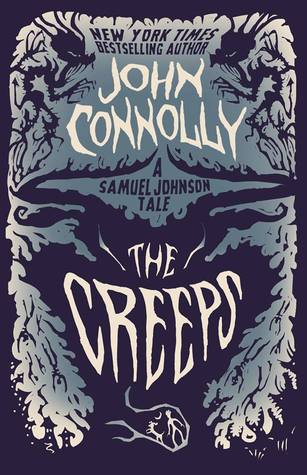
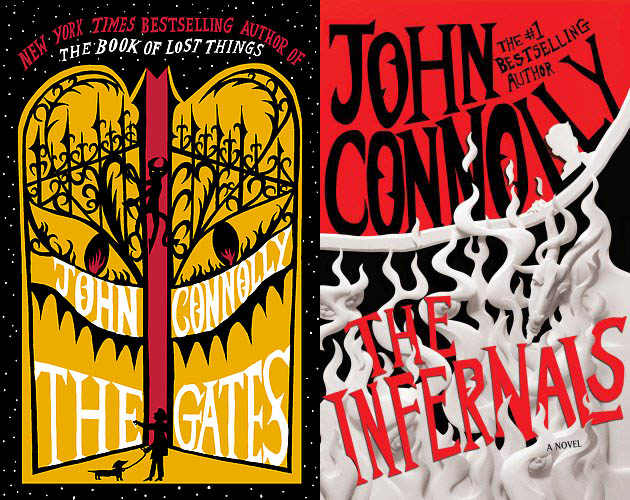
John Connolly is best known for his Charlie Parker novels. This trio of Young Adult fantasies is nothing like Connolly’s mysteries. In The Gates (2009) we’re introduced to a precocious 12=year-old named Samuel Johnson. And, of course, Samuel Johnson has a dog named Boswell. Samuel and Boswell witness the beginning of an invasion of our world by the demons of Hell. But, when Samuel tries to tell his Mother about the danger looming, she thinks he’s just kidding around. In The Infernals (2011) an angry demon seeks revenge on Samuel Johnson and Boswell for the events in The Gates. And in The Creeps (2013) Samuel Johnson and Boswell actually go to Hell as the Multi-verse hangs in the balance.
To write effective Young Adult novels, the characters need to be compelling, the action needs to be sensational, and the plot needs to be ingenious. While John Connolly’s The Gates, The Infernals, and The Creeps provide mild entertainment, these books are not going to attract a large, devoted audience. GRADE: B-
WHERE YOU GO IS NOT WHO YOU’LL BE: AN ANTIDOTE TO THE COLLEGE ADMISSIONS MANIA By Frank Bruni

“It’s not where you go to school, it’s what you DO when you get there.” That’s the message I give my students who are concerned about getting accepted by the four-year College or University they dream about. Of course, a lot of those dreams are created by the marketing departments of those Colleges and Universities. Higher Education is a business. Today, students are lured to expensive colleges where they end up taking out student loans and end up heavily in debt. Frank Bruni identifies rational search methods to match students with schools that provide good educations and that are affordable. Yes, attending an Ivy League school offers a different experience than attending the local community college. Your roommate is likely to have a multi-millionaire parent. But, beyond the networking aspects, the actual education might be roughly equivalent.
Class sizes at my College are capped at 32 students. At SUNY at Buffalo, the “elite” school in our area, many courses have 300 students in them. Vastly different learning experience! I learn all of my students’s names within a week or two. If you’re in an auditorium with 300 students, the professor will not be trying to learn anybody’s name. I urge all of my students who plan to attend a four-year College after getting their Associate’s Degree, to visit the College they’re interested in attending. Actually sit in on a class. Talk to other students and ask them what they think of that College. Students sometimes supply surprising answers. But the obsession for some students and their parents to be accepted by a “name” school is fueled by the emails, videos, and Internet marketing that seems to have run amok. No wonder most college graduates find themselves drowning in debt. Where You Go is Not Who You’ll Be is a good antidote to this Admissions mania. GRADE: A
TABLE OF CONTENTS:
INTRODUCTION
1. The Unsung Alma Maters
2. Throwing Darts
3. Obsessives at the Gate
4. Rankings and Wrongs
5. Beyond the Comfort Zone
6. From Tempe to Waterloo
7. An Elite Edge?
8. Strangled with Ivy
9. Humbled, Hungry, and Flourishing
10. Fire Over Formula
11. Beyond the B-Plus
AFTERWARD
Suggested Readings and Resources
Acknowledgements
About the Author
INDEX
10 CLOVERFIELD LANE

I saw the first Cloverfield movie back in 2008. It was filmed with a shaky, hand-held camera (ala The Blair Witch Project) and purported to be chronicling the disaster of a giant, alien monster (think Godzilla on a Bad Day) rampaging through New York City leaving destruction and death in its wake. It was okay.
Now, this second movie in what appears to be a franchise has shown up with the creepiness factor dialed way up. Mary Elizabeth Winstead is held by John Goodman in a fallout bunker. Goodman’s character insists the country is under attack and the outside air is dangerous to breathe. Mary Elizabeth Winstead is skeptical but soon learns something Bad is happening above the bunker. John Gallagher, Jr. plays Emmett, a handyman who helped Goodman build the bunker. When disaster strikes, he forced his way into the bunker, but discovers he’s in a difficult position. There’s psychological tension, but it’s stretched out too long for my taste. I liked the last 15 minutes best. GRADE: C+
ALL THE SINGLE LADIES: UNMARRIED WOMEN AND THE RISE OF AN INDEPENDENT NATION By Rebecca Traister
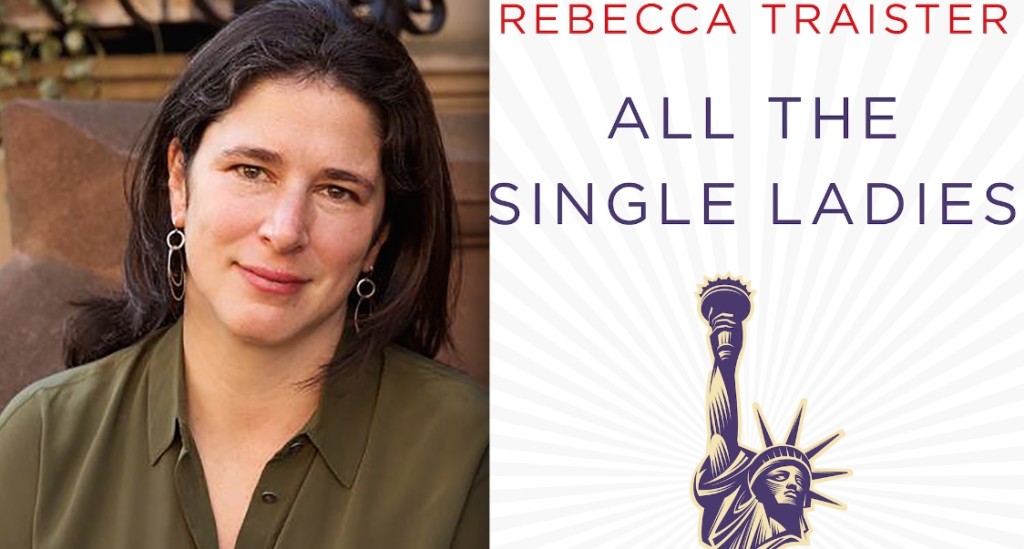
Rebecca Traister explores the strange new world of single women in the 21st Century. In previous centuries, women married in their early 20s. Today, less than 30% of women marry in their 20s. Marriage, which was formerly a goal for most women, is now an option. Traister shows how society changed, how economics made it possible for women to survive and thrive without a husband. I heard Rebecca Traister interviewed on National Public Radio and immediately ordered All the Single Ladies. Diane and I married at age 29 (which was considered “late” back then) but both our son and daughter are older than that and enjoy their singleness. Is marriage obsolete?
TABLE OF CONTENTS:
A Note on Interviews and Attibution
Introduction
CHAPTER ONE: Watch Out for that Women: The Poltical and Social Power of an Unmarried Nation
CHAPTER TWO: Single Women Hae Often Made History: Unmarried in America
CHAPTER THREE: The Sex of Cities: Urban Life and Female Independence
CHAPTER FOUR: Dangerous as Lucifer Matches: The Friendships of Women
CHAPTER FIVE: My Solitude, My Self: Sing Women on Their Own
CHAPTER SIX: For Richer: Work, Money, and Independence
CHAPTER SEVEN: For Poorer: Single Women and Sexism, Racism, and Poverty
CHAPTER EIGHT: Sex and the Single Girls: Virginity to Promiscuity and Beyond
CHAPTER NINE: Horse and Carriage: Maryying–And Not Marrying–In the Time of Singlehood
CHAPTER TEN: Then Comes What? And When?: Independence and Parenthood
Conduction
Appendix
Where Are They Now?
Acknowledgements
Selected Bibliography
Notes
BEAUTIFUL: THE CAROLE KING MUSICAL

Today Diane and I and Diane’s sister Carol are going to Shea’s Performing Arts Center to see Beautiful a musical based on the life and music of Carole King. Diane and I have been huge Carole King fans since the 1960s when she and her husband, Gerry Goffin, wrote hit after hit. Take a look at the songs in this musical to get a sense of some of the hits this dynamic team wrote. Later, King and Goffin broke up and Carole King launched a solo career with her iconic album, Tapasty. Katie saw Beautiful on Broadway and loved it. The reviews of this touring version have been very positive. What’s your favorite Carole King song?
Musical numbers:
All songs written by Goffin and King except as noted
Act 1
“Overture” – Orchestra
“So Far Away” – Carole King
“Oh! Carol” – Neil Sedaka
(music and lyrics by Neil Sedaka and Howard Greenfield)†
“1650 Broadway Medley” – Ensemble
(arranged by Douglas McGrath, music and lyrics by various artists)
“It Might as Well Rain Until September” – Carole
“Be-Bop-A-Lula” (music and lyrics by Tex Davis and Gene Vincent) – Ensemble†
“Some Kind of Wonderful” – Carole, Gerry Goffin and The Drifters
“Happy Days Are Here Again” – Cynthia Weil
(music by Milton Ager; lyrics by Jack Yellen)
“Take Good Care of My Baby” – Gerry and Carole
“Who Put the Bomp (in the Bomp, Bomp, Bomp)” – Barry Mann
(music and lyrics by Mann and Goffin)†
“Will You Love Me Tomorrow” – Carole
“He’s Sure the Boy I Love” – Cynthia and Barry
(music and lyrics by Mann and Weil)
“Will You Love Me Tomorrow” (Reprise) – The Shirelles
“Up on the Roof” – Gerry and The Drifters
“On Broadway” – The Drifters
(music and lyrics by Mann, Weil, Jerry Leiber and Mike Stoller)
“The Locomotion” – Little Eva and Ensemble
“You’ve Lost That Lovin’ Feeling” – The Righteous Brothers
(music and lyrics by Mann, Weil and Phil Spector)
“One Fine Day” – Janelle, Carole, and Ensemble
Act 2
“Chains” – Carole and Ensemble
“Walking in the Rain” – Barry and Cynthia
(music and lyrics by Mann, Weil and Spector)
“Pleasant Valley Sunday” – Marilyn Wald, Gerry, Carole and Ensemble
“We Gotta Get Out of This Place” – Barry
(music and lyrics by Mann and Weil)
“Will You Love Me Tomorrow” (Reprise) – Carole†
“Uptown” (music and lyrics by Mann and Weil) – Ensemble
“It’s Too Late” (music by King; lyrics by Toni Stern) – Carole
“You’ve Got a Friend” – Carole, Barry, Cynthia and Don
(music and lyrics by King)
“(You Make Me Feel Like) A Natural Woman” – Carole and Ensemble
(music and lyrics by Goffin, King and Gerald Wexler)
“Beautiful” (music and lyrics by King) – Carole
“I Feel the Earth Move” – Carole King and Ensemble
(music and lyrics by King)
SHADOW SHOW: ALL-NEW STORIES IN CELEBRATION OF RAY BRADBURY Edited by Sam Weller & Mort Castle
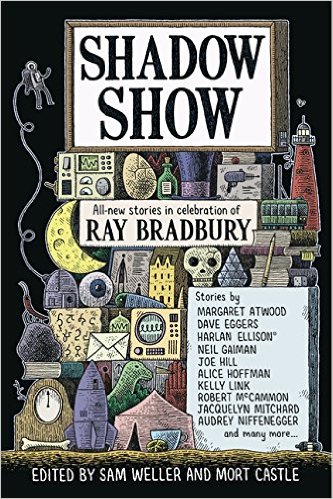
The ever generous Beth Fedyn sent me a copy of Shadow Show and I dropped everything and started reading it. The writers who contributed to this anthology in praise of Ray Bradbury were asked to submit stories that were Ray Bradbury-like or Ray Bradbury-inspired. Beth mentioned her favorite story in Shadow Show is Audrey Niffenegger;s “Backwards In Seville.” I really like Robert McCammon’s “Children of the Bedtime Machine” and Dan Chaon’s “Little America.” As you might suspect, there’s quite a range of stories in this anthology. And Weller and Castle asked the contributors to write a short essay included at the end of each story about their feelings about Ray Bradbury and his work. Fascinating stuff! What’s your favorite Ray Bradbury story?
TABLE OF CONTENTS:
Sam Weller and Mort Castle – Introduction
Ray Bradbury – Second Homecoming
*Neil Gaiman – The Man Who Forgot Ray Bradbury
*Margaret Atwood – Headlife
Jay Bonansinga – Heavy
*Sam Weller – The Girl In The Funeral Parlor
David Morrell – The Companions
Thomas F. Monteleone – The Exchange
Lee Martin – Cat on a Bad Couch
*Joe Hill – By The Silver Water Of Lake Champlain
*Dan Chaon – Little America
John McNally – The Phone Call
Joe Meno – Young Pilgrims
Robert McCammon – Children Of The Bedtime Machine
*Ramsey Campbell – The Page
Mort Castle – Light
Alice Hoffman – Conjure
John Maclay – Max
Jacqueline Mitchard – Two Of A Kind
Gary Braunbeck – Fat Man And Little Boy
*Bonnie Jo Campbell – The Tattoo
Audrey Niffenegger – Backwards In Seville
* Charles Yu – Earth: (A Gift Shop)
Julia Keller – Hayleigh’s Dad
Dave Eggers – Who Knocks?
Bayo Ojikutu – Reservation 2020
Kelly Link – Two Houses
Harlan Ellison – Weariness
CONTRIBUTORS
CREDITS
FORGOTTEN BOOKS #363: THE HUMAN CHORD/THE CENTAUR By Algernon Blackwood
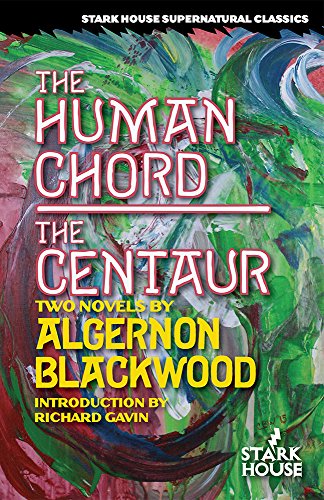
Algernon Blackwood is best known for his supernatural fiction and his ghost stories. Richard Gavin, in his Introduction to The Human Chord (1910) and The Centaur (1911), notes that “strong Cabalistic and Egyptian interests are woven through the fabric of The Human Chord.” The Human Chord features a scholarly clergyman who aspires to reach the higher realms of spirituality through finding the sound that will unlock access to those previously unattainable dimensions. The Centaur explores a similar theme by contrasting the world-view of men who dream and men who are skeptical. In all the works of Algernon Blackwood that I’ve read, there’s a quest to unravel the mysteries of Life. If you’re in the mood for some classic supernatural fiction, this Stark House double volume delivers.
Other Algernon Blackwood books published by STARK HOUSE are:
The Empty House & Other Stories/The Listener & Other Stories
Ten Minute Stories/Day and Night Stories
Jimbo/The Education of Uncle Paul
Pans Garden/Incredible Adventures
The Lost Valley/The Wolves of God
Juilus LeVallon/The Bright Messenger
The Face of Eearth
